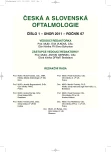Cardiovascular Diseases Occurrence in Patients with Pseudoexfoliative Syndrome and Pseudoexfoliative Glaucoma
Authors:
T. Benda
Authors‘ workplace:
Oční oddělení, Krajská zdravotní, a. s. - Masarykova nemocnice, Ústí nad Labem, primářka MUDr. Ivana Liehneová
Published in:
Čes. a slov. Oftal., 67, 2011, No. 1, p. 12-15
Category:
Original Article
Overview
A retrospective evaluation of cardiovascular disease (CV disease) in patients with pseudoexfoliative syndrome (PEX syndrome) and pseudoexfoliative glaucoma (PEX glaucoma) and their relationship to morphological and functional eye parameters. The main objective of this comparison was to identify parameters, that are among the groups with severe and mild CV disease statistically significantly different.
Methods and results:
Retrospective analysis of patients with PEX syndrome and PEX glaucoma. Evaluated were 46 eyes of 46 patients equally divided into two groups. In the group with PEX glaucoma and in the group with PEX syndrome was evaluated as an equivalent number of 23 patients. Monitored and statistically evaluated parameters were age, sex, the value of best corrected visual acuity, intraocular pressure, central corneal thickness, the cup/disc ratio, perimetry parameters MD (Mean deviation) and PSD (Pattern standard deviation). Age, sex of patients and the average values of monitored parameters are displayed on descriptive evaluative chart. Using the Mann-Whitney test were compared the observed signs among patients with severe and mild CV disease in a group of PEX syndrome and PEX glaucoma. CV disease was classified as mild (typically middle and medically well-controlled hypertension or heart disease with no associated events such as myocardial infarction, stroke, heart failure) or severe (CV disease-related event such as myocardial infarction, cerebrovascular stroke, heart failure or venous occlusion).
Conclusion:
We did not find a statistically significant difference in the incidence of mild and severe CV diseases among groups of patients with PEX syndrome and PEX glaucoma. Also, we did not find statistical difference in the monitored parameters of visual acuity, intraocular pressure, central corneal thickness, cup/disc ratio and perimetric parameters MD and PSD between the groups with mild and severe CV problems. The exception was the cup/disc ratio parameter in the group of patients with PEX glaucoma, where we found a lower value of cup/disc ratio in patients with severe CV diseases than patients with mild CV diseases.
Key words:
pseudoexfoliative syndrome, pseudoexfoliative glaucoma, cardiovascular disease
Sources
1. Flammer J.: Glaukom, Triton, 2003.
2. Kanski J. J.: Clinical Ophthalmology, A systemic approach, Sixth edition, Elsevier 2007.
3. Ludwisiak-Kocerba L., Hevelke A., Kecik D.: Pseudoexfoliation syndrome - etiopatogenesis and clinical course, Klin Oczna, 2006, 108(1–3): 82–6.
4. Mauricio E.P., Babak ER.: Glaucoma, Pseudoexfoliation, eMedicine Ophthalmology, 2010 Apr.
5. Ritch R., Schlötzer-Schrehardt U.: Exfoliation syndrome, Survey Ophthalmology, 2001 Jan-Feb, 45(4): 265–315.
6. Ritch R.: The management of exfoliative glaucoma, Prog Brain Res., 2008, 173: 211–24.
7. Skorkovská K.: Pseudoexfoliativní syndrom a glaukom v otázkách a odpovědích, Vydáno u příležitosti setkání na téma Pseudoexfoliace v Praze v roce 2007.
8. Tarkkanen A.: Is exfoliation syndrome a sign of systemic vascular disease? Acta Ophthalmologica, 2008 Dec, 86(8): 832–6.
Labels
OphthalmologyArticle was published in
Czech and Slovak Ophthalmology

2011 Issue 1
Most read in this issue
- Cardiovascular Diseases Occurrence in Patients with Pseudoexfoliative Syndrome and Pseudoexfoliative Glaucoma
- Contemporary Possibilities of Artificial Vision in Blind Patients Using Artificial Neuro-prosthesis – Review
- Longterm Efficiency of a Deep Sclerectomy with T-Flux Implant
- Cataract after Lightning Injury – Case Report
